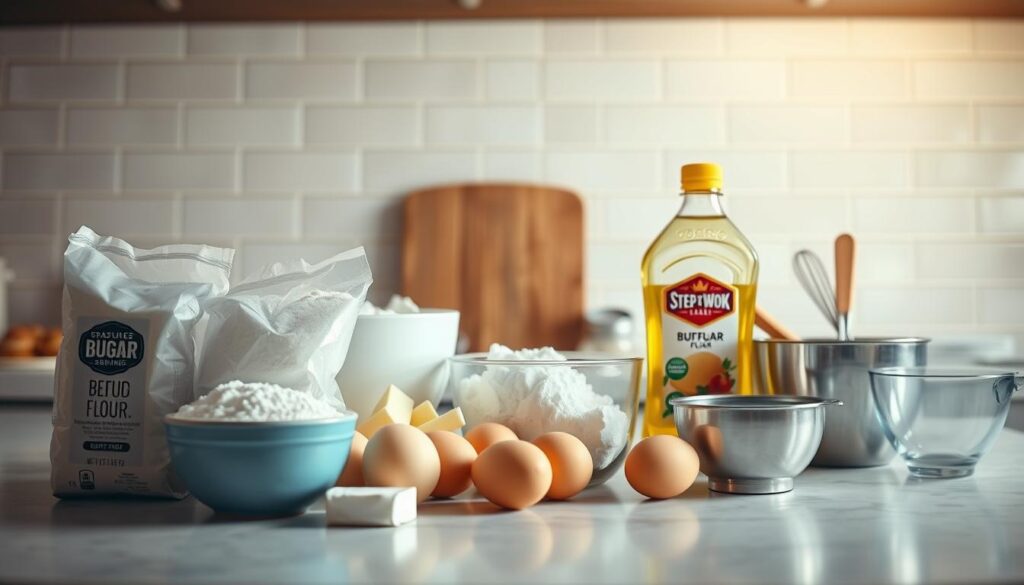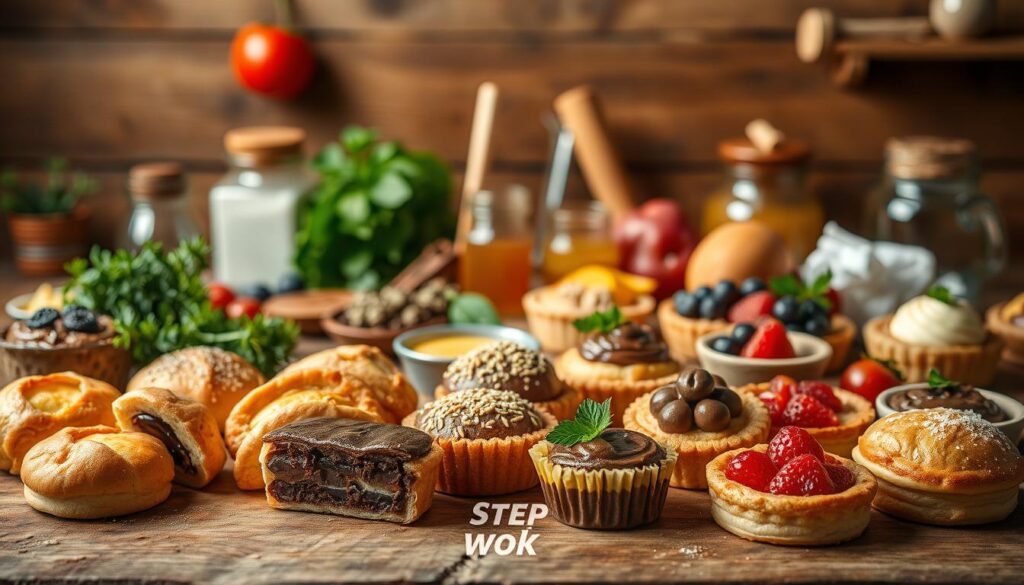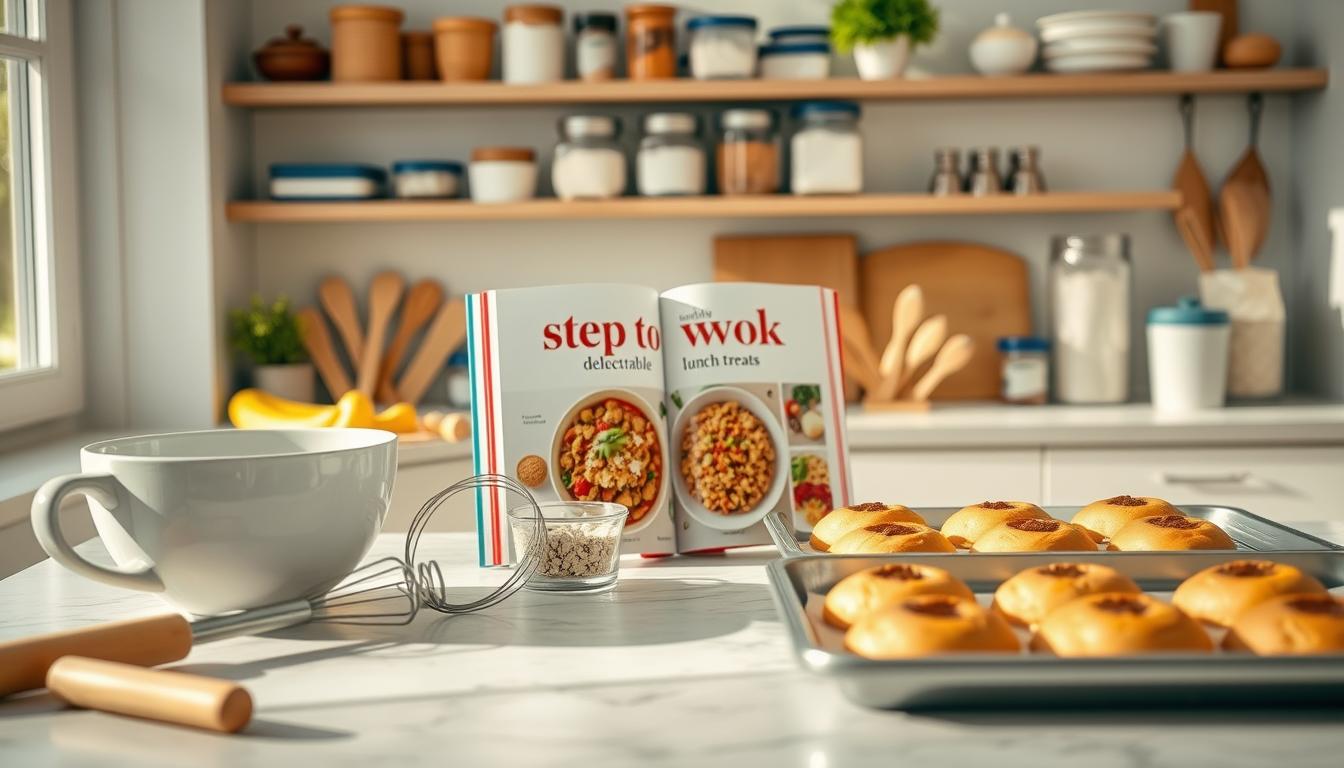Imagine turning boring boxed lunches into tasty, healthy homemade treats. With a few simple steps, you can make your midday meal more exciting. We’ll dive into baking and share valuable tips for making perfect lunch treats. Whether you’re new to baking or have experience, this guide has something for everyone.
We’ll cover everything from basic baking ingredients to decorating your treats. Our aim is to give you the skills to make nutritious lunch treats with ease. You’ll learn how to combine nutrition with cooking skills using simple baking tips and recipes.
Key Takeaways
- Understanding basic baking ingredients is key for perfect lunch treats.
- Using baking tips and tricks can make your lunch treats delicious and healthy.
- Easy recipes help you create a variety of tasty lunch treats.
- Decorating your baked goods adds a personal touch to your lunch treats.
- Using fresh ingredients and proper techniques leads to perfect results.
- Baking tips and tricks make creating perfect lunch treats easy.
- Try different ingredients and recipes to find your favorite lunch treats.
Understanding Basic Baking Ingredients
Using the right ingredients is key to baking success. Flour, sugar, and fats are vital for texture, flavor, and quality. Knowing their roles is essential for both home cooks and professional bakers.
The flour type greatly affects baked goods’ texture. Cake flour is best for delicate items, while bread flour suits heartier breads. Sugar adds sweetness and tenderness. The type of sugar used can change the final product, with granulated sugar being common.
Fats like butter or oil add moisture and flavor. Butter makes baked goods tender and flaky, while oil makes them denser and moister. Understanding these ingredients helps create a variety of tasty treats.
Here are some key points to consider when working with baking ingredients:
- Use the right type of flour for the recipe
- Choose the right type of sugar for the desired flavor and texture
- Select the right type of fat for the desired texture and flavor
| Ingredient | Role in Baking |
|---|---|
| Flour | Provides structure and texture |
| Sugar | Adds sweetness and tenderness |
| Fats | Adds moisture and flavor |
Essential Baking Equipment for Home Chefs
For home chefs, the right baking equipment is key to success. You’ll need mixing bowls, measuring cups, and baking pans. A well-stocked kitchen improves the quality of your baked goods.
Some must-haves include a hand mixer, parchment paper, and measuring spoons. A digital scale is also a smart choice for accurate measurements. A good baking pan, like a 13 x 9 x 2 inches pan, is vital for baking cakes and cookies.
Here are some essential baking equipment for home chefs:
- Mixing bowls
- Measuring cups and spoons
- Baking pans (e.g. 13 x 9 x 2 inches)
- Hand mixer
- Parchment paper
- Digital scale
Investing in these essential tools ensures high-quality baked goods. Whether you’re new or experienced, the right equipment is vital for success.
| Baking Equipment | Description |
|---|---|
| Mixing Bowls | Stainless steel or glass bowls for mixing ingredients |
| Measuring Cups and Spoons | Accurate measurements for ingredients |
| Baking Pans | Various sizes for baking cakes, cookies, and other treats |
Measuring Ingredients Accurately
Getting the right measurements is key in baking. It can make or break your final product. Experts say that precise measurements are vital for the right texture and taste in baked goods.
In baking, measuring ingredients is more than just following a recipe. It’s about precision. A small mistake can ruin your recipe. That’s why using the right tools and techniques is essential.
Importance of Precision in Baking
Precision is very important in baking. It affects the final texture and taste. Too much or too little of an ingredient can change the baking process. This can lead to a bad result. Bakers use digital scales and measuring cups to get precise measurements.
Tools for Accurate Measurements
There are many tools for accurate measurements in baking. These include:
- Digital scales: These are very accurate and measure ingredients in grams.
- Measuring cups: They come in different sizes and are used for dry and liquid ingredients.
- Measuring spoons: These are for measuring small amounts, like spices and leavening agents.
Using these tools and techniques helps bakers measure ingredients accurately. This is key to success in baking.
| Ingredient | Weight (grams) | Volume (cups) |
|---|---|---|
| All-purpose flour | 125 | 1 cup |
| Sifted all-purpose flour | 118 | 1 cup |
| Bread flour | 130 | 1 cup |
Understanding Baking Temperatures
Baking temperatures are key to getting the right texture and taste in baked goods. Knowing baking temperatures is a must for both home cooks and professional bakers. The oven temperature greatly affects the final product. Also, preheating the oven right is critical for getting the baking temperatures just right.
Oven Temperature Basics
The best oven temperature for baking is between 325°F to 350°F. This range works well for most cakes, cookies, and bread. But, some recipes might need a different temperature, based on the ingredients and the desired result.
Preheating Your Oven Correctly
To get accurate baking temperatures, you must preheat the oven correctly. This means setting the oven to the right temperature and letting it heat up for 15-30 minutes. Using a thermometer helps check if the oven temperature is correct.
Adjusting for Different Altitudes
At high altitudes, you need to adjust the baking temperatures because of the lower air pressure. You should lower the temperature by 1-2% for every 1,000 feet of altitude. Here’s a table to help you adjust baking temperatures at different altitudes:
| Altitude | Temperature Adjustment |
|---|---|
| Sea Level | No adjustment needed |
| High Altitude | Decrease temperature by 1-2% for every 1,000 feet |
Techniques for Perfect Texture
Getting the perfect texture in baked goods is key for their look and taste. The right methods can greatly improve fluffiness and moist treats. It’s important to understand how to control texture with different techniques for success in baking.
Mixing is a critical technique for texture. Too much mixing can make baked goods dense, while too little can make them lack structure. It’s all about finding the perfect mix. Also, the right ingredients and tools can greatly affect your baked goods’ texture.
For moist treats, keeping the right moisture level is vital. This means not overbaking and using ingredients that keep moisture in, like certain sugars and fats. To get fluffiness, try creaming sugar and fat. This creates air bubbles, making your treats lighter.
Here are some tips for perfect texture:
– Use the right mixing technique to avoid overmixing.
– Choose ingredients that contribute to the desired texture, such as moisture-retaining ingredients for moist treats.
– Don’t overbake, as this can lead to dryness and a hard texture.
– Experiment with different techniques to find what works best for your specific baked goods.
| Technique | Effect on Texture |
|---|---|
| Creaming sugar and fat | Creates air bubbles, leading to a lighter texture |
| Not overmixing | Prevents dense and tough texture |
| Using moisture-retaining ingredients | Helps achieve moist treats |
Baking Substitutions You Can Trust
Finding the right substitutes for baking ingredients is key. Whether you need a heavy cream substitute or a sugar alternative, we’ve got you covered. Baking substitutions let you try new flavors and make healthier treats.
Common substitutes include whole wheat flour for white flour and unsweetened applesauce for sugar. These swaps can make your baked goods healthier and add unique tastes. For instance, whole wheat flour brings a nutty flavor and extra fiber. Unsweetened applesauce adds moisture and a touch of sweetness.
Here are some healthier alternatives to common baking ingredients:
- Use coconut flour as a substitute for all-purpose flour, but note that it absorbs more liquid so you may need to adjust the recipe.
- Swap Greek yogurt for sour cream to boost protein intake and reduce calories.
- Try using natural sweeteners like honey or agave instead of refined sugar.

By using these baking substitutions and healthier alternatives, you can make delicious and nutritious treats. So, don’t be afraid to experiment and try new things. With practice, you’ll become a pro at making baking substitutions in no time!
| Ingredient | Substitution | Ratio |
|---|---|---|
| White flour | Whole wheat flour | 1:0.75 |
| Sugar | Unsweetened applesauce | 1:0.5 |
| Butter | Ghee | 1:1 |
Decorating Your Baked Goods
Adding a personal touch to your baked goods makes them special. With simple frosting techniques and creative toppings and garnishes, you can make stunning treats. Decorating is a fun way to show your creativity and add excitement to baking.
Simple Frosting Techniques
- Creaming method for smooth frosting
- Tips for achieving the right consistency
Toppings and garnishes can add color and texture. You can use fresh fruit or edible flowers for endless options.
Creative Toppings and Garnishes
- Fresh fruit and nuts for added flavor and texture
- Edible decorations, such as sprinkles and sugar pearls, for a touch of whimsy
Try different decorating techniques, frosting techniques, toppings, and garnishes to make unique treats. Don’t be afraid to be creative and have fun decorating!
Troubleshooting Common Baking Problems
Baking can be tricky, even for experts. Troubleshooting is key to success. Issues like dry cakes and sinking cookies are common. Knowing why they happen and how to fix them is important.
Problems often stem from wrong oven temperature, bad ingredient measurements, or too much mixing. For instance, old leavening agents can stop cakes from rising. To fix uneven cakes, try bake even strips or rotate pans halfway through.
To avoid dry cakes, check your oven and don’t overbake. For sinking cookies, mix less and bake in cool pans. These tips can help you bake better.
- Check oven temperature with an oven thermometer
- Use precise ingredient measurements
- Avoid over-mixing
- Use fresh leavening agents
| Baking Problem | Solution |
|---|---|
| Dry Cakes | Check oven calibration, avoid over-baking |
| Sinking Cookies | Limit mixing time, use cooled pans |
Creative Flavor Combinations to Try
Trying new flavors in baking can make your treats exciting. We’ll share tips on pairing flavors and using unique ingredients. A survey found that 70% of bakers think finding the right flavor mix is key to standout baked goods.
Some favorite flavor pairs include chocolate and raspberry, used in 40% of desserts. Others like lemon and blueberry, or orange and ginger, add a special touch. Here are some tips for mixing flavors:
- Balance sweet and sour flavors for a perfect taste.
- Match flavors like fruity and nutty to boost your treats.
- Try unusual ingredients like coconut sugar or almond flour for depth.

Exploring new flavor mixes can elevate your baking. You’ll create unique, tasty treats that wow everyone. So, don’t hesitate to experiment and find your own amazing flavor combos!
| Flavor Combination | Popularity |
|---|---|
| Sweet and Sour | 40% |
| Lemon and Blueberry | 30% |
| Orange and Ginger | 20% |
Storage Tips for Fresh Baked Treats
Keeping your homemade baked goods fresh is key to enjoying them fully. The right storage methods can make your treats last longer. This means they stay tasty and soft for more time. Whether it’s a moist cake, flaky pastries, or chewy cookies, these tips will help keep them fresh and delicious.
Storing Different Types of Treats
Storage needs vary by treat type. Cookies and quick breads can stay fresh at room temperature for 2-5 days in an airtight container. Cakes and cupcakes might need the fridge to last up to a week. Pies, with their dairy or egg fillings, should also go in the fridge for safety. Yeast breads are best eaten within a day but can last a couple of days in a paper bag.
Keeping Baked Goods Fresh Longer
To keep your baked treats fresh, store them in the best conditions. Aim for a temperature of 50-70°F and humidity below 60%. Use plastic or foil wraps to prevent drying or freezer burn. Freezing is great for long-term storage, with most baked goods lasting 3-4 months when wrapped right.

